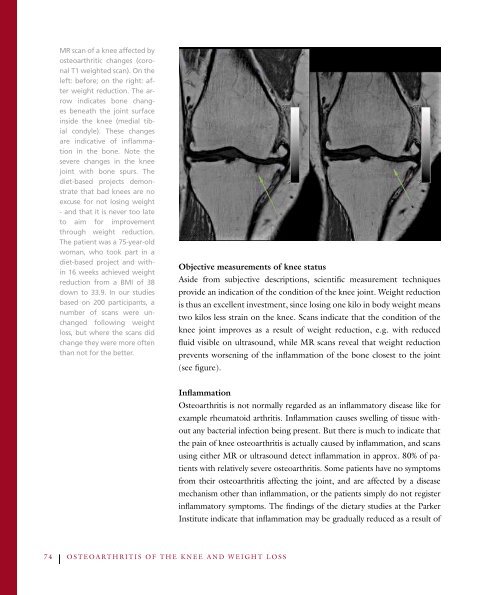Home to the skylark - The Velux Foundations
Home to the skylark - The Velux Foundations
Home to the skylark - The Velux Foundations
Create successful ePaper yourself
Turn your PDF publications into a flip-book with our unique Google optimized e-Paper software.
MR scan of a knee affected by<br />
osteoarthritic changes (coronal<br />
T1 weighted scan). On <strong>the</strong><br />
left: before; on <strong>the</strong> right: after<br />
weight reduction. <strong>The</strong> arrow<br />
indicates bone changes<br />
beneath <strong>the</strong> joint surface<br />
inside <strong>the</strong> knee (medial tibial<br />
condyle). <strong>The</strong>se changes<br />
are indicative of inflammation<br />
in <strong>the</strong> bone. Note <strong>the</strong><br />
severe changes in <strong>the</strong> knee<br />
joint with bone spurs. <strong>The</strong><br />
diet-based projects demonstrate<br />
that bad knees are no<br />
excuse for not losing weight<br />
- and that it is never <strong>to</strong>o late<br />
<strong>to</strong> aim for improvement<br />
through weight reduction.<br />
<strong>The</strong> patient was a 75-year-old<br />
woman, who <strong>to</strong>ok part in a<br />
diet- based project and within<br />
16 weeks achieved weight<br />
reduction from a BMI of 38<br />
down <strong>to</strong> 33.9. In our studies<br />
based on 200 participants, a<br />
number of scans were unchanged<br />
following weight<br />
loss, but where <strong>the</strong> scans did<br />
change <strong>the</strong>y were more often<br />
than not for <strong>the</strong> better.<br />
Objective measurements of knee status<br />
Aside from subjective descriptions, scientific measurement techniques<br />
provide an indication of <strong>the</strong> condition of <strong>the</strong> knee joint. Weight reduction<br />
is thus an excellent investment, since losing one kilo in body weight means<br />
two kilos less strain on <strong>the</strong> knee. Scans indicate that <strong>the</strong> condition of <strong>the</strong><br />
knee joint improves as a result of weight reduction, e.g. with reduced<br />
fluid visible on ultrasound, while MR scans reveal that weight reduction<br />
prevents worsening of <strong>the</strong> inflammation of <strong>the</strong> bone closest <strong>to</strong> <strong>the</strong> joint<br />
(see figure).<br />
Inflammation<br />
74 OSTEOARTHRITIS OF THE KNEE AND WEIGHT LOSS<br />
Osteoarthritis is not normally regarded as an inflamma<strong>to</strong>ry disease like for<br />
example rheuma<strong>to</strong>id arthritis. Inflammation causes swelling of tissue with-<br />
out any bacterial infection being present. But <strong>the</strong>re is much <strong>to</strong> indicate that<br />
<strong>the</strong> pain of knee osteoarthritis is actually caused by inflammation, and scans<br />
using ei<strong>the</strong>r MR or ultrasound detect inflammation in approx. 80% of pa-<br />
tients with relatively severe osteoarthritis. Some patients have no symp<strong>to</strong>ms<br />
from <strong>the</strong>ir osteoarthritis affecting <strong>the</strong> joint, and are affected by a disease<br />
mechanism o<strong>the</strong>r than inflammation, or <strong>the</strong> patients simply do not register<br />
inflamma<strong>to</strong>ry symp<strong>to</strong>ms. <strong>The</strong> findings of <strong>the</strong> dietary studies at <strong>the</strong> Parker<br />
Institute indicate that inflammation may be gradually reduced as a result of<br />
weight reduction. Given that inflammation is <strong>the</strong> primary source of pain in<br />
osteoarthritis, it is worth considering whe<strong>the</strong>r <strong>the</strong> improvement achievable<br />
from weight reduction is attributable not only <strong>to</strong> alleviation of <strong>the</strong> weight<br />
burden on <strong>the</strong> knee but also <strong>to</strong> a reduction of <strong>the</strong> inflammation.<br />
Medication for osteoarthritic pain<br />
Recognition of <strong>the</strong> significance of inflammation for <strong>the</strong> pain of knee osteo-<br />
arthritis has led <strong>to</strong> revised treatment regimens. Common medication for<br />
inflamma<strong>to</strong>ry pain, NSAIDs such as ibuprofen, are widely used <strong>to</strong> alleviate<br />
osteoarthritic pain, but since NSAIDs have side effects, <strong>the</strong>y are not re-<br />
commended for long-term pain relief.<br />
<strong>The</strong> outlook<br />
<strong>The</strong> treatment available for knee osteoarthritis is currently very variable in<br />
Denmark. An improvement in <strong>the</strong> condition may be achieved from weight<br />
reduction programmes for people with obesity, combined with physical<br />
exercise regimes, and even if it ends in a knee replacement, <strong>the</strong>se activities<br />
will provide a better foundation for post-operative rehabilitation.<br />
However, <strong>the</strong> first choice in pain relief during <strong>the</strong> process has not been<br />
determined, nor whe<strong>the</strong>r it is significant <strong>to</strong> reduce inflammation for ex-<br />
tended periods.<br />
Most cases of knee osteoarthritis<br />
are affected by inflammation,<br />
commonly involving<br />
<strong>the</strong> accumulation of excess<br />
joint fluid, “water on<br />
<strong>the</strong> knee”. Removing <strong>the</strong> fluid<br />
relieves <strong>the</strong> symp<strong>to</strong>ms, and<br />
since <strong>the</strong> abnormal joint fluid<br />
contains substances that degrade<br />
tissue, fluid draining is<br />
a form of <strong>the</strong>rapy in itself.<br />
VELUX FOUNDATION<br />
75<br />
AGEING RESEARCH AND OPHTHALMOLOGY



